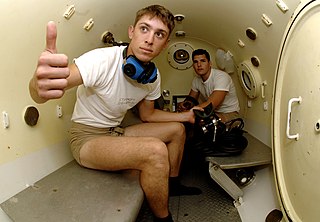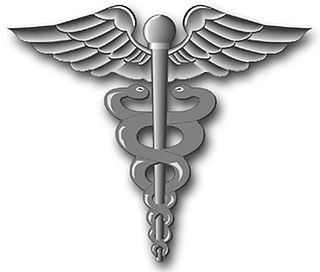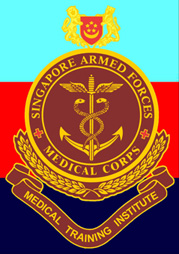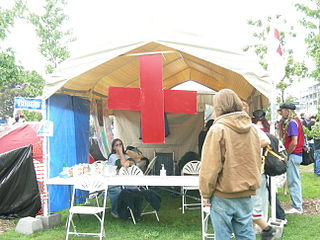A combat medical technician (CMT) is a soldier with a specialist military trade within the Royal Army Medical Corps of the British Army.
A combat medical technician (CMT) is a soldier with a specialist military trade within the Royal Army Medical Corps of the British Army.
The fully trained combat medical technician or CMT is capable of:
Additionally, at Class 1 the CMT is trained in the procedures and principles of Battlefield Advanced Trauma Life Support (BATLS), which includes advanced life support, cricothyrotomy and thoracentesis.

Emergency Medical Technician (EMT), Paramedic and Ambulance Technician are terms used in some countries to denote a health care provider of emergency medical services. EMTs are clinicians, trained to respond quickly to emergency situations regarding medical issues, traumatic injuries and accident scenes.

Battlefield medicine, also called field surgery and later combat casualty care, is the treatment of wounded combatants and non-combatants in or near an area of combat. Civilian medicine has been greatly advanced by procedures that were first developed to treat the wounds inflicted during combat. With the advent of advanced procedures and medical technology, even polytrauma can be survivable in modern wars. Battlefield medicine is a category of military medicine.

The Mobile Army Surgical Hospital (MASH) refers to a United States Army medical unit serving as a fully functional hospital in a combat area of operations. The units were first established in August 1945, and were deployed during the Korean War and later conflicts. The term was made famous in the television series M*A*S*H, which depicted a fictional MASH unit. The U.S. Army deactivated the last MASH unit on February 16, 2006. The successor to the Mobile Army Surgical Hospital is the Combat Support Hospital.

For the more current term, see Emergency medical responder
The Seattle & King County Emergency Medical Services System is a fire-based two-tier response system providing prehospital basic and advanced life support services.

A medic is a person involved in medicine such as a medical doctor, medical student and sometimes a medically-trained individual participating in an emergency such as a paramedic or an emergency medical responder.

Casualty evacuation, also known as CASEVAC or by the callsign Dustoff or colloquially Dust Off, is a military term for the emergency patient evacuation of casualties from a combat zone. Casevac can be done by both ground and air. "DUSTOFF" is the callsign specific to U.S. Army Air Ambulance units. CASEVACs by air today are almost exclusively done by helicopter, a practice begun on a small scale toward the end of World War II; before that, STOL aircraft, such as the Fieseler Fi 156 or Piper J-3 were used. Casevac aircraft are a non-standardized and non-dedicated vehicle that does not necessarily have en route care, which is used to get a casualty back to another location where they can be treated by professional medical staff.

Diving medicine, also called undersea and hyperbaric medicine (UHB), is the diagnosis, treatment and prevention of conditions caused by humans entering the undersea environment. It includes the effects on the body of pressure on gases, the diagnosis and treatment of conditions caused by marine hazards and how relationships of a diver's fitness to dive affect a diver's safety.

A field hospital is a small mobile medical unit, or mini hospital, that temporarily takes care of casualties on-site before they can be safely transported to more permanent facilities. This term is used overwhelmingly with reference to military situations, but may also be used in times of disaster. The concept was inherited from the battlefield and is now applied in case of disasters or major accidents, as well as with traditional military medicine.

Combat medic or field medic is a US term for military personnel who have been trained to at least an EMT-B level, and are responsible for providing first aid and frontline trauma care on the battlefield. They are also responsible for providing continuous medical care in the absence of a readily available physician, including care for disease and battle injuries. Combat medics are normally co-located with the combat troops they serve in order to easily move with the troops and monitor ongoing health. Other countries have similar services, but this article is primarily concerned with the US provision.

A hospital corpsman is an enlisted medical specialist of the United States Navy, who may also serve in a U.S. Marine Corps unit. The corresponding rating within the United States Coast Guard is health services technician (HS).
In the United States Army and Marine Corps, a battalion aid station is a medical section within a battalion's support company. As such, it is the forwardmost medically staffed treatment location.

The SAF Medical Training Institute is a military medicine training institute under the Army Medical Service within the SAF Medical Corps. As part of the medical corps, the institute oversees the medical vocational training for national servicemen and servicewomen under the Army, Navy, Air Force and the Singapore Civil Defence Force.

An aid station is a temporary facility established to provide supplies to endurance event participants or medical first aid and provisions during major events, disaster response situations, or military operations.

The Defence Chemical, Biological, Radiological and Nuclear Centre is a United Kingdom military facility at Winterbourne Gunner in Wiltshire, south of Porton Down and about 4 miles (6 km) northeast of Salisbury. It is a tri-service location, with the Army being the lead service. The centre is responsible for all training issues relating to chemical, biological, radiological and nuclear (CBRN) defence and warfare for the UK's armed forces.

The Army Mountain Warfare School (AMWS) is a United States Army school located at the Camp Ethan Allen Training Site, Jericho, Vermont to train soldiers in mountain warfare, the specialized skills required for operating in mountainous terrain. It is home to the 86th Infantry Brigade Combat Team. The school is located in Vermont's Green Mountains.

The 28th Combat Support Hospital is a Combat Support Hospital of the United States Army. It was first constituted in 1943 and served in China during World War II. During the Gulf War in 1990, it was the first Army hospital unit established and deployed into Iraq with combat forces of the XVIII Airborne Corps. More recently it has been involved in relief operations following natural disasters and has undertaken several recent deployments to Iraq. Currently the unit falls under the command of the 44th Medical Brigade and is based at Fort Bragg, North Carolina.
68W is the Military Occupational Specialty (MOS) for the United States Army's Combat Medic. 68Ws are primarily responsible for providing emergency medical treatment at point of wounding on the battlefield, limited primary care, and health protection and evacuation from a point of injury or illness. This specialty is open to males and females with minimum line scores of 107 GT and 101 ST on the Armed Services Vocational Aptitude Battery.

The US Army Combat Lifesaver Course is an official medical training course conducted by the US Army, intended to provide an intermediate step between the buddy aid-style basic life support taught to every soldier and the advanced life support skills taught only to US Army Combat Medics.

A diving team is a group of people who work together to conduct a diving operation. A characteristic of professional diving is the specification for minimum personnel for the diving support team. This typically specifies the minimum number of support team members and their appointed responsibilities in the team based on the circumstances and mode of diving, and the minimum qualifications for specified members of the diving support team. The minimum team requirements may be specified by regulation or code of practice. Specific appointments within a professional dive team for which competences are specified and registration may be required are listed below.
This article includes a list of references, related reading or external links, but its sources remain unclear because it lacks inline citations .(June 2008) (Learn how and when to remove this template message) |